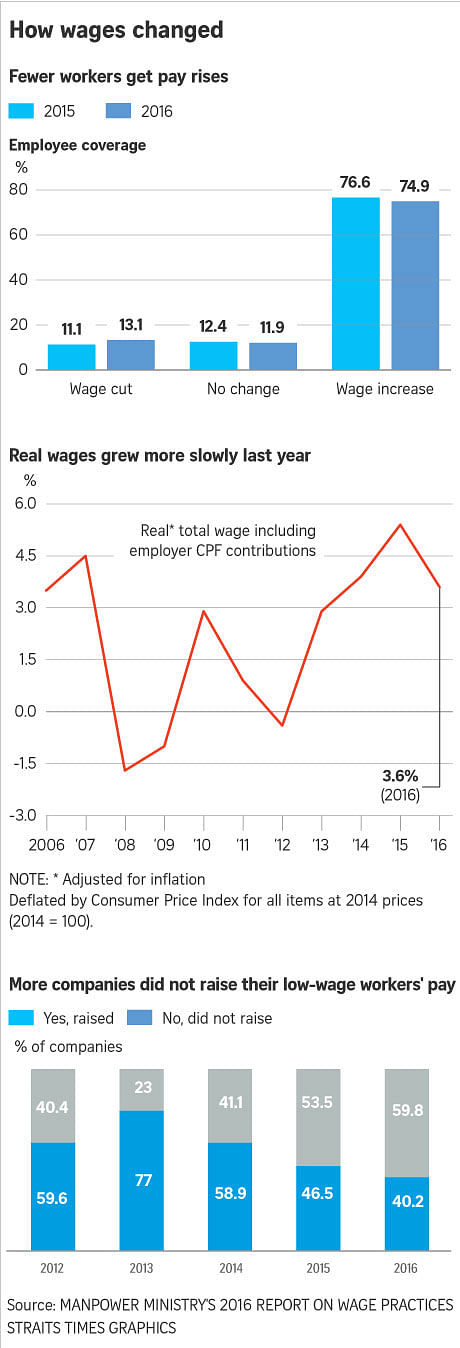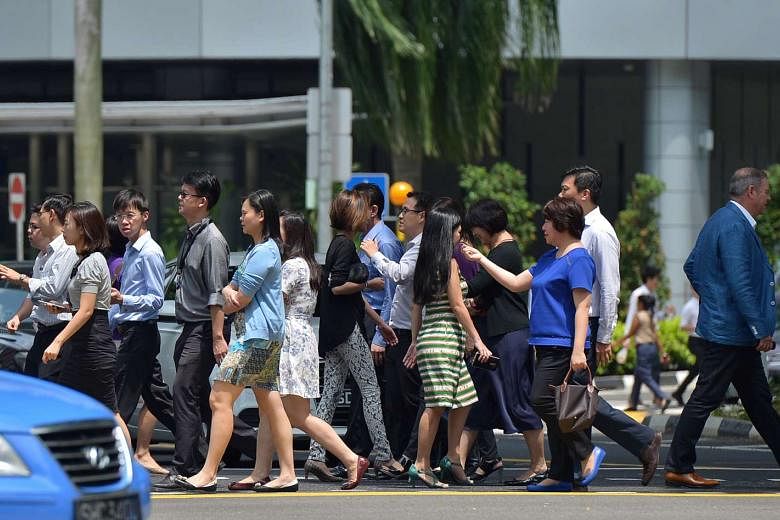SINGAPORE - Fewer workers received pay increases last year as more companies struggled to turn in a profit amid slowing economic growth.
Real wages also grew at a slower rate, rising 3.6 per cent last year compared to 5.4 per cent in 2015, after accounting for negative inflation of 0.5 per cent.
A Ministry of Manpower (MOM) survey shows that only 58 per cent of the 4,800 companies with at least 10 employees raised total wages last year, down from 64 per cent in 2015.
This means that out of the 1,232,800 workers surveyed, 75 per cent got a pay raise, down from 77 per cent in 2015.
The survey findings, given in the annual Report on Wage Practices released on Tuesday (May 30), also shows the pay rise workers received was not as good as the previous year.
Last year's increase was 4.9 per cent, a decline from 5.6 per cent in 2015.

A bigger proportion of companies cut workers' pay last year: around 17 per cent compared to 11 per cent in 2015.
The cuts were also steeper: 5 per cent last year compared to 4.7 per cent in 2015.
These ups and downs are a reflection of the tough times faced by companies in Singapore.
More companies made losses
The share of loss-making companies crept up for the third year in a row, hitting 24.3 per cent last year.
This was the highest proportion of companies in the red in the last 10 years.
MOM said the decline was "broad-based across major industries, and among small and medium enterprises (SMEs) with fewer than 200 employees".
The proportion of profitable companies in manufacturing fell from 77 per cent in 2015 to 69 per cent last year; from 81 per cent to 78 per cent in construction; and from 78 per cent to 77 per cent in services.
Among SMEs, it slid from 78 per cent to 75 per cent.
Even among profitable companies, a bigger proportion said they had not done as well as in the year before: 40.6 per cent compared to 37.6 per cent in 2015.
Fewer companies, or 22.6 per cent of them, also said they made the same amount of profit as in the year before, compared to the 28.9 per cent in 2015.
MOM noted that nine in 10 private-sector employees now work in companies with some form of flexible wage system, the highest since 2004.
As a result, businesses can adjust wages accordingly when they do not do so well, a move that explains last year's slower wage growth.
Bonuses stayed the same at 2.17 months of basic wage last year.
But a bigger proportion of companies said they tied bonuses to market conditions and their own performance, compared to an employee's performance.
Last year, the economy was sluggish, growing at 2 per cent, which is barely an improvement on 1.9 per cent a year ago.
What analysts say
The economy is expected to do slightly better this year.
DBS economist Irvin Seah said that this should increase wages in externally-oriented sectors like financial services, which are buoyed by better global demand.
But other sectors like domestic services will still struggle as they face structural challenges.
"Some clusters are disrupted by new technology and will continue to find it tough-going," Mr Seah said, citing the retail sector competing with e-commerce.
"Any improvement in wages will be uneven,"he added.
Labour economist Randolph Tan, of the Singapore University of Social Sciences, also noted that unemployment may worsen as Singapore grapples with a mismatch between jobs created and the existing skills of workers.
"It will not make much sense to expect significant wage growth until the situation has stabilised a bit more," he said.
The full report is available on MOM's website here.

